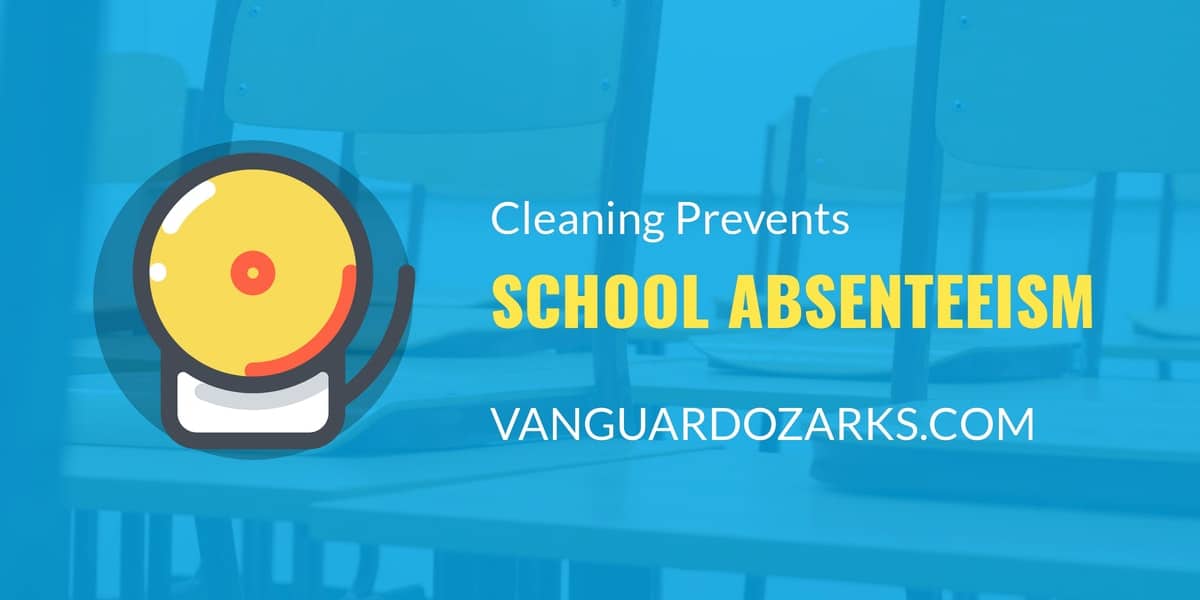Regular cleaning and daily disinfection services have been shown in several studies to prevent student and teacher absenteeism, resulting in higher test scores, improved performance, and a significantly higher return on public and private investment.

Regular Cleaning Prevents Student and Teacher Absenteeism in Schools
Healthier classrooms translate into higher attendance rates, resulting in more productive teachers and better-performing students.
Unfortunately, a significant wakeup call is needed for school administrators and district supervisors.
Adequate budgeting and cleaning protocols can go a long way toward reducing absenteeism for both students and faculty; a direct link to higher test scores and funding from the government for public facilities.
In 2015-16, nearly 800 school districts nationally reported that 30 percent of their students missed at least 15 days.
Notable culprits behind those totals are acute illnesses and asthma, both conditions that can be significantly contained through proper cleaning protocol and equipment.
The Importance of School Attendance
Regular attendance, especially early on, has a significant impact on long-term quality of life and economic outcomes for students.
However, studies have shown that:
- Over 8 million students missed three or more weeks of school during the 2015-16 academic year.
- One in ten kindergarten and first-grade students are considered chronically absent.
- 17% of chronically absent students in kindergarten and first grade were deemed to be proficient at reading by the end of third-grade.
- Chronic absenteeism by sixth grade is a leading indicator that a child will drop out of high school.
- Missing two days of school each month, or roughly ten percent of the year negatively impacts academic performance.
The Financial Burden of Student and Teacher Absenteeism
Public school districts generate revenue based, in part, on student attendance.
The average student generates $65.34 per day, totaling approximately $10.7 billion annually nationwide.
The cost of 8 million students missing 15 days of school is roughly $7.8 billion per year.
The average teacher misses approximately 5.3 days of school per year.
The estimated cost for hiring a substitute teacher ranges between $75-$125 per day, totaling $530 million annually.
Additional estimates place the financial burden of the loss of productivity due to teacher absenteeism at approximately $5.6 billion.
The Impact of Health on Absenteeism
Student and teacher health has a tremendous impact on school attendance.
Statistically, acute illness is the most commonly cited reason for school absence--approximately 76%.
According to the Georgetown University Health Policy Institute;
When we talk about absenteeism in this country, we tend to think about skipping school and truancy.
But the reality is that illness and the lack of access to health care contribute to a whole lot of missed days.
Many of these absences are excused, but the kids are still missing school and missing out on instruction.
In some cases, the illness is the barrier to attendance.
Students with asthma, for instance, miss 14 million days of school a year.
School Attendance and Health Care: Why Chronic Absenteeism Isn’t Just About Truancy
The Environmental Impact of Classrooms on Occupant Health
According to certain studies, it is estimated that only 39% of schools dust low surfaces each day.
Students exposed to dust containing the highest levels of phthalates--a chemical found in a wide range of products, including toys, vinyl flooring, wall coverings, and fragrances--are 2.9 times more likely to have asthma than students exposed to the lowest levels.
Further, coronaviruses, such as influenza, can survive on surfaces commonly found in classrooms and other school facilities for up to seven days.
Regular cleaning focused on:
- High touch-point disinfection.
- Custodial training.
- The elimination of cross-contamination, and;
- The use of environmentally-preferable cleaning products;
will significantly reduce student absenteeism.
Experts agree schools should use dual-bucket cleaning systems that keep dirty and clean water separate, as well as microfiber mops and cloths.
Custodial staffs should also have cleanup kits for dealing with bodily fluids, and receive proper education on dealing with such spills.
If a school’s focus is on cleaning for health, green products are the safest choice, says Bishop.
Every surface in the school should be cleaned regularly.
Most important, however, are areas where cross-contamination is likely.
That means any high-touch point that easily allows for germs and infections to be transferred from person to person.
References & Resources
Takeaway
Student and teacher absenteeism is a chronic issue plaguing our nation.
Improving the quality of cleaning and the rate of disinfection in the classroom and throughout the school's facilities are cost-effective methods for eliminating the germs and environmental toxins that lead to these issues and a lifetime of unnecessary and preventable struggle.
Outsourcing your advanced disinfection and environmentally-preferred cleaning requirements to a highly-trained and dedicated service provider will ensure the rapid onboarding of mission protocols, absent the challenges of implementing new policies with inexperienced staff.
Contact us today and discover why Vanguard Cleaning Systems® is the Standard of Clean® for businesses throughout Northwest Arkansas, Missouri, and Oklahoma.
In Oklahoma, dial 918-960-4450
In Arkansas, dial 479-717-2410
In Missouri, dial 417-812-9777

